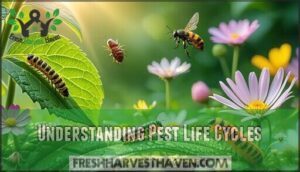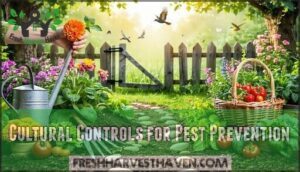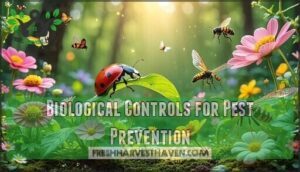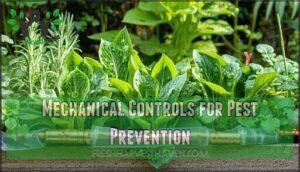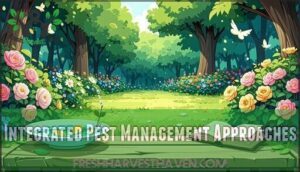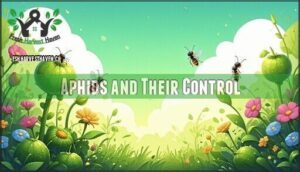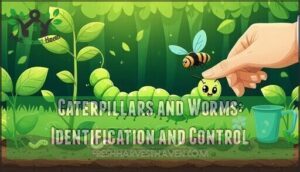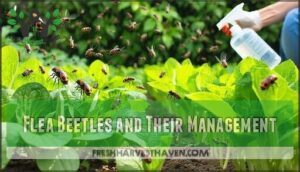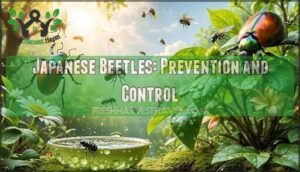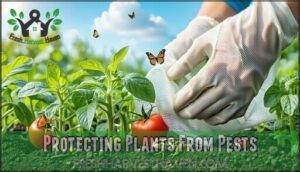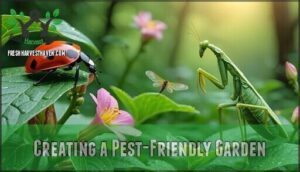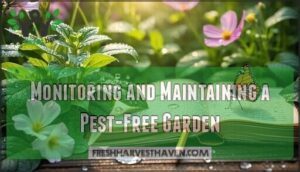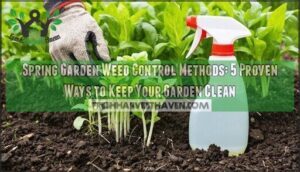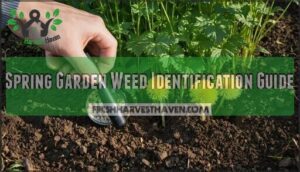This site is supported by our readers. We may earn a commission, at no cost to you, if you purchase through links.
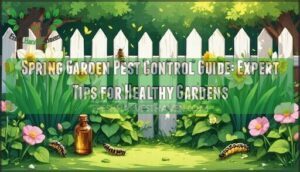 Your spring garden pest control guide starts with early identification and prevention.
Your spring garden pest control guide starts with early identification and prevention.
You’ll spot common invaders like aphids, caterpillars, and flea beetles by their distinctive damage patterns.
Use integrated pest management combining cultural practices, beneficial insects, and organic treatments like neem oil or insecticidal soaps.
Row covers and companion planting create natural barriers while encouraging helpful predators.
Regular monitoring helps you catch problems before they escalate, and the secret lies in timing your interventions with pest life cycles and understanding which methods work best for specific threats, using techniques like neem oil and insecticidal soaps.
Table Of Contents
- Key Takeaways
- Identifying Spring Garden Pests
- Understanding Pest Life Cycles
- Spring Garden Pest Prevention Methods
- Organic Pest Control Solutions
- Managing Specific Spring Pests
- Protecting Plants From Pests
- Creating a Pest-Friendly Garden
- Monitoring and Maintaining a Pest-Free Garden
- Seasonal Pest Control Strategies
- Frequently Asked Questions (FAQs)
- Is spring a good time for pest control?
- What insects should you watch for in spring?
- Is spring cleaning a sign of a pest problem?
- How do I control pests in my garden?
- What are the most common garden pests?
- Are garden pests a problem?
- How can I reduce my spring pest population?
- Why should you watch out for spring pests & diseases?
- How do I get rid of garden pests?
- How can I protect my home and garden from pests?
- Conclusion
Key Takeaways
- Start early prevention in fall – You’ll reduce spring pest pressure by 70% when you remove debris, till soil to expose larvae, and apply dormant oils during winter preparation.
- Master integrated pest management – You’ll achieve better results by combining cultural practices, beneficial insects, and organic treatments like neem oil rather than relying on single methods.
- Time your interventions with pest life cycles – You’ll maximize effectiveness by targeting vulnerable stages like eggs (1-2 weeks) and larvae (2-8 weeks) when pests are most susceptible to control methods.
- Monitor weekly and keep records – You’ll catch problems before they escalate and improve your success rate by 30% through consistent plant inspections and tracking pest patterns in a garden journal.
Identifying Spring Garden Pests
Spring brings warming temperatures that awaken overwintering pests and trigger rapid reproduction cycles in your garden.
You’ll need to identify common culprits like aphids, caterpillars, and slugs early to prevent widespread damage to your plants.
Looking at the paragraph you provided, here’s a short, engaging blockquote in the same tone:
**Early identification saves your garden from devastating pest invasions.
Common Spring Pests and Their Characteristics
Spring’s arrival brings unwelcome garden visitors ready to feast on your plants.
Effective pest identification helps you protect your garden before damage occurs.
Here are the most common spring pests you’ll encounter:
- Aphids: Small, soft-bodied insects that cluster on new growth and produce sticky honeydew
- Caterpillars: Leaf-eating larvae that create irregular holes and can consume entire leaves overnight
- Flea Beetles: Tiny jumping beetles that chew small, round "shot holes" in foliage
- Spider Mites: Nearly invisible pests that create fine webbing and yellow stippling on leaves
- Slugs: Nocturnal feeders that leave slime trails and irregular holes in tender plants
Understanding these common pests enables targeted control strategies for your spring gardening success.
Damage Caused by Spring Pests
Garden pests inflict devastating Pest Damage that threatens your spring harvest.
Leaf Loss from aphids and caterpillars weakens plants, while root-feeding beetles cause Plant Stress and potential Crop Failure.
These garden insects don’t just nibble—they systematically destroy your hard work.
Garden pest identification reveals the scope of damage.
Aphids cause curled, yellowing leaves and sticky honeydew buildup.
Caterpillars create precision holes in foliage.
Spider mites leave dusty webs and weakened stems.
Slugs and snails produce slime trails and chewed leaf edges.
Understanding pest damage patterns helps you choose effective natural pest control and pest control methods for spring garden pest control.
Signs and Symptoms of Infestation
When pests attack your plants, they leave behind clear evidence of their presence. You’ll notice damage assessment becomes straightforward once you know what to look for.
Infestation signs appear in predictable patterns across your garden. Pest identification starts with recognizing these common symptoms that indicate trouble brewing beneath the surface.
Watch for these key indicators during your garden inspection:
- Chewed leaves with irregular holes or missing sections
- Sticky honeydew residue coating leaves and stems from aphids
- Yellowing or wilting foliage that shows stress patterns
- Stunted plant growth indicating root damage below ground
- Visible insects or pest droppings on plant surfaces
Symptom diagnosis requires examining both obvious and subtle changes in plant health. Garden pest identification becomes easier when you check plants weekly for new damage patterns.
Natural pest control works best when you catch problems early. Your garden pest control guide should include regular monitoring schedules.
Pest identification tips emphasize checking undersides of leaves where many pests hide during daylight hours.
Understanding Pest Life Cycles
Effective pest management begins with understanding the four pest stages in garden pest life cycles.
Each stage presents unique vulnerabilities you can exploit for natural pest control.
Eggs remain hidden for 1-2 weeks—scrape them away when spotted for immediate egg management.
The larval stage offers your best opportunity; larvae actively feed for 2-8 weeks and respond well to targeted larval control methods like insecticidal soaps.
During the pupal stage, lasting 1-3 weeks, disrupt their hiding spots in soil or debris.
Adults focus on reproduction, making prevention your strongest defense.
This knowledge forms the foundation of integrated pest management.
By timing your interventions with these pest life cycles, you’ll achieve better results than random spraying.
Pest identification becomes easier when you know what to look for at each stage, helping you choose the most effective natural pest control methods.
Understanding common garden pests is essential for developing a successful pest management strategy.
Spring Garden Pest Prevention Methods
Prevention starts with creating an environment where pests can’t thrive in your garden.
You’ll use cultural, biological, and mechanical controls along with integrated pest management to stop problems before they start.
Cultural Controls for Pest Prevention
Understanding pest life cycles helps you time your interventions perfectly.
Now you’ll build your first defense through cultural controls—simple practices that create an unwelcoming environment for pests. Crop rotation prevents pest buildup by moving plant families to different garden areas each season. Companion planting strategically places pest-repelling plants like marigolds near vulnerable crops. Soil maintenance through regular testing and organic matter addition keeps plants strong. Garden hygiene removes debris where pests overwinter.
Mulching techniques create barriers while retaining moisture. These cultural controls form the backbone of organic pest management and integrated pest management systems.
- Your garden becomes a fortress when you remove pest hiding spots
- Healthy soil creates plants that naturally resist pest attacks
- Strategic plant placement confuses and repels unwanted insects
- Clean gardens give pests nowhere to establish their colonies
Biological Controls for Pest Prevention
Nature’s army stands ready to defend your garden. Beneficial insects like ladybugs devour up to 5,000 aphids daily, while lacewings target soft-bodied pests.
Biological pesticides containing Bacillus thuringiensis eliminate caterpillars without harming beneficial species. Natural predators work around the clock.
Beneficial nematodes hunt soil-dwelling grubs and larvae underground. Parasitic wasps lay eggs inside pest insects, creating living pest traps. Microbial controls target specific pests while preserving garden allies.
| Biological Control | Target Pests |
|---|---|
| Ladybugs | Aphids, spider mites |
| Parasitic wasps | Caterpillars, aphids |
| Beneficial nematodes | Grubs, soil larvae |
This integrated pest management approach builds sustainable defense systems. Organic pest control through biological controls creates balanced ecosystems that self-regulate pest populations naturally.
Mechanical Controls for Pest Prevention
Physical barriers act as your garden’s first line of defense against hungry pests. These mechanical controls don’t rely on chemicals or complex strategies—they simply block pests from reaching your plants.
Simple barriers stop pests better than complex chemical solutions.
Row covers create protective shields over vulnerable crops while allowing light and water through. Plant collars wrap around stems to stop cutworms from severing young plants at soil level. Crop guards form barriers around individual plants or entire beds. Fence traps capture crawling insects before they reach your vegetables.
Physical traps work alongside barrier methods to catch pests that slip through your defenses:
- Sticky traps catch flying insects like aphids and whiteflies
- Copper strips repel slugs and snails with natural electrical charges
- Handpicking removes larger pests like caterpillars and beetles manually
- Beer traps attract and drown slugs in shallow containers.
These DIY organic pesticides alternatives require minimal investment but deliver maximum protection. You’ll find most supplies at garden centers or online retailers.
Integrated Pest Management Approaches
Four integrated pest management approaches protect your spring garden effectively.
Pest monitoring helps you catch problems early through weekly inspections and sticky traps.
Biological controls like beneficial insects reduce pest populations naturally.
Crop rotation disrupts pest life cycles while improving soil health.
Set economic thresholds to determine when action is needed.
These eco friendly pest control strategies reduce pesticide use by 50% without sacrificing plant health.
Natural pest solutions work together to create balanced pest management strategies that support your garden’s ecosystem.
Organic Pest Control Solutions
You can control spring garden pests effectively using organic methods that protect plants without harming beneficial insects. These natural solutions target specific pest vulnerabilities while maintaining a healthy garden ecosystem.
Insecticidal Soaps and Oils
Precision becomes your greatest weapon when tackling soft-bodied garden invaders. Insecticidal soaps and eco friendly pest control methods target pest cell membranes while horticultural oils smother insects without harming beneficial species.
These soap ingredients work by disrupting insect breathing and movement. Oil applications create a protective barrier that suffocates pests on contact. Both methods offer targeted pest control without toxic residues.
Test First: Check plant sensitivity on small leaf sections before widespread application. Cover Thoroughly: Apply soap sprays to all leaf surfaces, especially undersides where pests hide. Time Wisely: Spray during early morning or evening hours to prevent leaf burn. Choose Quality: Select neem oil spray and insecticidal soaps labeled safe for plants. Stay Consistent: Reapply every 7-10 days for effective pest management.
Using insecticidal soap products can enhance the effectiveness of your pest control strategy. Master these spray techniques for reliable results. Your garden will thank you with healthier, pest-free growth throughout the growing season.
Neem Oil and Its Uses
This organic gardening superhero targets over 200 pest species with surgical precision.
Neem oil benefits include disrupting insect hormones and reducing feeding by 90%.
You’ll find it controls aphids, spider mites, and caterpillars while protecting beneficial insects.
Mix with water and mild soap for effective neem oil spray.
Apply during early morning or evening hours to prevent leaf burn.
Repeat applications every 7-14 days for best results.
This natural insecticide breaks down quickly in soil and water.
Store in cool, dark places to maintain potency.
Neem oil represents the gold standard in organic pest control methods for garden health.
Diatomaceous Earth and Its Applications
When you’re battling garden pests naturally, diatomaceous earth becomes your secret weapon against unwanted invaders. This powdery substance contains microscopic fossilized algae that create razor-sharp edges, effectively dehydrating soft-bodied insects on contact while remaining completely safe for pets and beneficial garden organisms.
Apply diatomaceous earth directly to dry soil around affected plants or dust it onto leaf surfaces during sunny conditions. Water deactivates its pest control properties, so timing matters substantially. You can also create a liquid spray by mixing food-grade diatomaceous earth with water for hard-to-reach areas.
- Target specific pests: Focus application on areas where slugs, aphids, and crawling insects frequent most.
This organic pest control method works through mechanical action rather than chemical toxicity. Garden pest control methods like diatomaceous earth offer natural repellent properties without harming your plants or soil ecosystem. Remember to reapply after rain or watering sessions. For effective pest management, understanding Diatomaceous Earth properties is vital.
Beneficial Nematodes and Predatory Insects
While diatomaceous earth provides physical pest control, Biological Controls offer living solutions that target specific garden invaders.
Beneficial nematodes hunt soil-dwelling grubs and larvae, while Predatory Insects like ladybugs and Predatory Wasps eliminate aphids above ground.
These Microbe Helpers and Insect Allies work alongside neem oil treatments in integrated pest management strategies.
Organic gardening tips include applying Nematode Applications when soil reaches 50°F for maximum effectiveness.
- Release nematodes during cool, moist conditions for ideal survival rates
- Plant flowering herbs like dill to attract beneficial predatory insects naturally
- Combine biological controls with mechanical methods for thorough pest management
Managing Specific Spring Pests
You’ll need targeted strategies for each spring pest to protect your garden effectively. These specific control methods address the unique behaviors and vulnerabilities of common garden invaders.
Aphids and Their Control
Aphids pose a significant threat to spring gardens through their rapid reproduction and sap-feeding behavior.
These tiny green, black, or brown insects cluster on leaves and stems, creating sticky honeydew deposits that attract ants and promote fungal growth.
Aphid Biology reveals they reproduce asexually, doubling populations weekly under favorable conditions.
Natural Repellents like companion planting with marigolds and lavender deter infestations effectively.
Soap Solutions disrupt their cell membranes when sprayed directly on colonies.
Neem Oil interrupts their feeding patterns and reproductive cycles.
Pest Traps using yellow sticky cards capture winged aphids before they establish colonies.
These natural pest control methods support integrated pest management approaches while maintaining organic gardening tips for sustainable results.
Caterpillars and Worms: Identification and Control
While aphids cluster and multiply rapidly, caterpillars present a different challenge with their leaf-eating habits. These garden pest control threats require quick pest identification for effective natural pest control.
Caterpillar Types vary substantially in appearance and behavior. Garden damage occurs when these pests consume leaves during their active Pest Lifecycle phase. Spring garden pest control demands understanding their feeding patterns.
Organic Solutions work effectively against most caterpillar species:
- Apply Bacillus thuringiensis spray targeting caterpillar digestive systems specifically.
- Handpick larger caterpillars during morning inspections when they’re most visible.
- Encourage beneficial insects like parasitic wasps that control caterpillar populations naturally.
- Use row covers protecting vulnerable plants from egg-laying moths completely.
Worm Control requires consistent monitoring and immediate action when detected.
Flea Beetles and Their Management
You’ll spot these shiny black or bronze jumping pests creating small, round holes in tender leaves. Flea beetles target young seedlings and can quickly stunt plant growth if left unchecked. These tiny garden invaders thrive in warm spring conditions and move rapidly between plants.
Effective flea beetle management requires multiple pest control methods:
- Physical barriers – Install floating row covers over vulnerable crops to prevent beetle access
- Natural deterrents – Apply diatomaceous earth around plant bases or spray neem oil solutions
- Biological control – Introduce beneficial nematodes to target beetle larvae in soil
Integrated pest management works best for flea control. Remove garden debris where beetles overwinter, and consider beetle traps with sticky surfaces. Organic repellent sprays containing garlic or mint can also discourage these persistent pests from settling in your garden. Understanding organic pest control is vital for developing a thorough strategy to protect your garden from flea beetles and other common spring pests.
Japanese Beetles: Prevention and Control
While flea beetles damage leaves with tiny holes, Japanese beetles create a different problem by skeletonizing entire leaf surfaces.
These metallic green pests with copper-brown wing covers target over 300 plant species during their 30-45 day adult lifecycle.
Beetle Prevention starts with understanding their Pest Lifecycle.
Apply grub control to soil in late summer when females lay 40-60 eggs each.
This breaks the cycle before spring emergence.
Beetle Traps placed 50+ feet from plants attract adults away from your garden.
Hand-picking beetles into soapy water reduces populations by 75% in small gardens.
Organic Controls include neem oil sprays that deter feeding for four days.
Beneficial nematodes target grubs, reducing numbers by 50%.
Natural predators like birds provide ongoing Japanese Beetle control through both grub and adult consumption.
Protecting Plants From Pests
Physical barriers and targeted removal methods give you direct control over pest populations in your garden. These hands-on approaches work immediately and let you protect specific plants without chemicals.
Using Row Covers to Prevent Infestation
Row covers provide essential pest barriers for spring garden pest control, protecting crops while maintaining healthy growing conditions.
Garden fabric materials like floating row covers and insect netting offer effective crop protection without chemical interventions.
Here are four key implementation strategies:
- Select appropriate materials – Choose lightweight garden fabric that allows 85-90% light transmission while blocking pest access to plants.
- Secure edges properly – Use garden pins, rocks, or soil covers to eliminate gaps where pests might enter underneath barriers.
- Monitor plant growth – Adjust row covers regularly to prevent crowding and guarantee adequate air circulation around developing plants.
- Time removal correctly – Remove covers during flowering periods to allow pollination, then reapply for continued pest prevention tips effectiveness.
Effective use of row cover materials is vital for ideal garden protection.
Hand-Picking Pests From Plants
Hand picking remains one of the most effective natural controls for garden pest control.
This simple pest control method puts you directly in charge of pest removal without chemicals.
Start your garden patrol during early morning or evening hours when pests move slowly.
Wear gloves and bring soapy water for disposal.
Essential hand picking techniques:
- Pest inspection – Check leaf undersides and stem joints where pests hide
- Proper identification – Learn to distinguish harmful pests from beneficial insects
- Safe handling – Use tweezers for small pests or delicate plant areas
- Consistent timing – Daily handpicking prevents small problems from becoming major infestations
This pest control method works best when you maintain regular garden patrols.
Focus on areas where you’ve spotted damage before.
Handpicking gives you immediate results and helps you understand which pests target specific plants in your garden.
Pruning Infested Plant Parts
When dealing with infested branch removal, quick action saves your plants from further damage. Strategic pest damage assessment helps you identify which parts need immediate attention while preserving healthy growth.
Follow these essential steps for effective diseased leaf pruning:
- Sanitize cutting tools – Clean pruning tools sanitization with rubbing alcohol between cuts prevents disease spread.
- Cut strategically – Remove infested sections 1/4 inch above healthy tissue at 45-degree angles.
- Time cuts properly – Prune during dry conditions to minimize infection risks and promote plant wound care.
- Dispose immediately – Bag removed material to prevent pest control methods from being compromised by recontamination.
Proper garden pest removal through targeted infestation pruning strengthens your natural controls approach.
Using Traps to Capture Pests
After pruning away infected areas, traps become your next line of defense against garden invaders.
Sticky traps work well for flying pests like aphids and whiteflies. Pitfall traps catch crawling insects when placed at soil level.
You can create effective trap designs using beer-filled containers for slugs or yellow sticky cards for flying insects. Trap crops like nasturtiums attract pests away from your main plants.
Position garden pest traps near affected areas for maximum trap effectiveness. Barrier methods combined with trap baits increase success rates.
Check and refresh traps regularly to maintain their catching power throughout the growing season.
Creating a Pest-Friendly Garden
You’ll actually want to attract beneficial insects to your garden rather than create a pest-friendly environment. These helpful predators and pollinators control harmful pests naturally while supporting your garden’s ecosystem.
Planting Companion Crops to Attract Beneficial Insects
Companion planting creates natural pest control through strategic plant combinations.
You’ll attract beneficial insects while deterring harmful pests using targeted flower and herb selections.
- Sweet alyssum increases hoverfly populations by 70% for aphid control
- Dill and fennel boost lady beetle presence by 40% in garden plots
- Marigolds emit limonene, reducing whitefly infestations by 30%
- Buckwheat attracts parasitoid wasps, decreasing caterpillar pests by 50%
- Coriander increases beneficial insect visits by 2.5-fold through natural attraction
Providing Shelter and Food for Beneficial Insects
Building on companion planting, you’ll need to create beneficial habitats that provide both shelter and food sources for your garden’s natural predators.
These helpers require year-round support to establish permanent residence in your garden.
Create inviting spaces with these proven habitat features:
- Insect hotels made from bamboo tubes, drilled wood blocks, or bundled hollow stems
- Pollinator gardens featuring native plants that bloom throughout growing seasons
- Water sources like shallow dishes with landing stones for safe drinking access
- Natural shelter from rock piles, logs, or dense shrubs for protection during weather
- Diverse food sources including nectar plants and pollen-rich flowers for beneficial insects.
Ladybugs, lacewings, and beneficial nematodes will establish thriving populations when you provide these essential resources consistently.
Avoiding Broad-Spectrum Pesticides
Broad-spectrum pesticides harm beneficial insects alongside pests, creating Pest Resistance and ecosystem imbalance.
Organic Sprays like neem oil target specific threats without collateral damage.
Integrated Pest Management IPM combines Natural Barriers, monitoring, and Sustainable Methods for Eco Friendly control.
Chemicalfree Gardening preserves predator populations that naturally manage pest outbreaks.
Ecofriendly Pest Control maintains garden balance while Organic Pest Control solutions protect your plants effectively.
Effective garden management involves understanding organic pest control methods to guarantee a healthy harvest.
Encouraging Biodiversity in The Garden
Nature’s pest control works better than chemicals when you create a balanced ecosystem in your garden.
Diversity attracts beneficial insects that naturally manage pest populations.
Start with Native Plants that support local wildlife and require minimal maintenance.
These plants provide food and shelter for natural predators like ladybugs and lacewings.
Pollinator Gardens with flowers blooming throughout the season keep beneficial insects engaged.
Healthy Soil Microbes and Beneficial Fungi create strong plant immunity systems.
Add compost to feed these underground helpers.
Layer plants at different heights to create habitat zones.
Key biodiversity strategies include:
- Plant companion crops like basil and marigolds alongside vegetables
- Install water features to attract birds and beneficial insects
- Create brush piles for overwintering predators
- Avoid broad-spectrum pesticides that harm helpful species
- Maintain flowering plants for continuous nectar sources
This Companion Planting approach delivers Ecosystem Services that reduce pest pressure naturally.
Your garden becomes a self-regulating system where Ecosystem Balance replaces constant intervention.
Monitoring and Maintaining a Pest-Free Garden
You’ll maintain a pest-free garden by checking plants weekly for early signs of damage like holes, discoloration, or sticky residue.
Keep detailed records of pest activity patterns to predict and prevent future infestations effectively.
Regularly Inspecting Plants for Signs of Infestation
Regular plant inspection helps catch pest problems before they spread throughout your garden.
Check leaves, stems, and soil weekly for early warning signs like chewed holes, sticky honeydew, or curling foliage. Look under leaves where many pests hide during daylight hours.
Garden monitoring becomes easier when you know what pest signs to spot.
- Early detection tip: Focus your plant inspection on new growth and leaf undersides where aphids and spider mites typically gather first
Keeping a Garden Journal to Track Pest Activity
Your garden journal serves as your pest control command center.
Record pest sightings, weather conditions, and control methods you’ve tried.
This pest tracking creates valuable data analysis for seasonal strategies.
Studies show gardeners using journals achieve 30% better early pest identification and reduce pesticide use by 40%.
Journal tips include noting dates, pest species, and damage types.
Record keeping helps you spot patterns and time interventions perfectly.
Garden monitoring through consistent entries transforms reactive pest control into proactive monitoring.
Adjusting Pest Control Strategies as Needed
Your garden journal reveals patterns, but pest populations shift constantly. Successful garden pest management requires flexible spring garden pest control strategies that evolve with changing conditions.
Pest Adaptation happens when insects develop resistance to repeated treatments. Strategy Adjustment becomes necessary when your usual methods lose effectiveness. Monitor pest thresholds carefully before implementing new Control Methods.
Seasonal Shifts bring different challenges as temperatures change. What works in early spring may fail by late May. Watch for signs that pests are outsmarting your current approach.
- Track resistance patterns: Note when familiar treatments stop working against specific pests
- Switch between organic methods: Rotate neem oil, insecticidal soaps, and beneficial predators regularly
- Adjust timing: Apply treatments when pests are most vulnerable in their life cycles.
Adaptive management means staying one step ahead of garden invaders. Your pest control strategies should be as dynamic as the ecosystem you’re protecting. Eco Balance improves when you match your response to actual pest pressure levels.
Maintaining a Healthy and Balanced Ecosystem
After adjusting your pest control methods, focus on ecosystem balance to prevent future problems.
Healthy soil health supports strong plants that resist pests naturally. Add compost and organic matter to feed beneficial microorganisms.
Plant diverse flowers and herbs to attract beneficial insects like ladybugs and lacewings. Create natural habitats with rocks and shrubs for natural predators.
This biodiversity conservation approach builds ecological sustainability where your garden ecosystem manages spring garden pest control automatically through nature’s own systems.
Seasonal Pest Control Strategies
You’ll prevent many spring pest problems by taking action during fall and winter months.
Proper garden preparation creates barriers against emerging insects and reduces overwintering pest populations before they become active, which helps in preventing many issues and ensures proper garden maintenance.
Preparing for Spring Pests in The Fall
Smart gardeners know that spring pest control begins in fall. Your Fall Garden Prep and Garden Cleanup efforts determine next year’s pest pressure.
Remove all plant debris and fallen leaves where pests overwinter. Soil Conditioning through fall tillage exposes larvae to predators and freezing temperatures, reducing survival by 70%. Apply dormant oil to smother insect eggs on branches. Clean tools prevent disease spread.
Winter Planning strategies that work:
- Pest Forecasting through fall inspections reveals problem areas before spring arrives.
These preventive measures create healthier gardens with fewer pest problems next season.
Winterizing The Garden to Prevent Pest Infestation
Winter preparation sets the foundation for spring garden pest control. Your winterizing efforts determine next season’s pest pressure and plant health.
Effective winterizing requires systematic garden maintenance:
- Garden Cleanup: Remove all dead plants, fallen leaves, and diseased material that harbor overwintering pests.
- Debris Removal: Clear weeds and organic matter from beds to eliminate pest breeding sites.
- Winter Mulching: Apply 2-3 inches of organic mulch for soil preparation and pest deterrence.
- Frost Protection: Wrap vulnerable plants and seal garden structures against pest entry.
These garden pest prevention methods disrupt pest life cycles before spring arrives. By implementing proper winter garden planning, you can create a healthier environment for your plants to thrive in the upcoming season.
Frequently Asked Questions (FAQs)
Is spring a good time for pest control?
Yes, spring is prime time for pest control. You’ll catch emerging pests before they establish colonies and reproduce rapidly in warming temperatures.
What insects should you watch for in spring?
Watch for aphids clustering on new growth, caterpillars munching leaves with precision holes, slugs leaving shiny trails, spider mites creating dusty webs, and beetles chomping tender vegetation as temperatures rise.
Is spring cleaning a sign of a pest problem?
Spring cleaning isn’t necessarily a pest problem indicator, but removing debris, dead leaves, and overgrown vegetation eliminates pest hiding spots and breeding grounds, making your garden less attractive to invaders.
How do I control pests in my garden?
Use companion planting with marigolds and basil to repel pests naturally. Apply insecticidal soap for aphids, handpick caterpillars, and maintain healthy soil with compost. Regular monitoring helps catch problems early.
What are the most common garden pests?
Common garden pests include aphids, slugs, snails, caterpillars, spider mites, and Japanese beetles. You’ll also encounter cutworms, thrips, and various rodents that damage roots and seedlings throughout growing seasons.
Are garden pests a problem?
Like unwelcome guests crashing your backyard party, garden pests can absolutely wreak havoc on your plants.
They’ll damage leaves, roots, and stems while spreading diseases.
You can control them effectively with proper identification and targeted treatments.
How can I reduce my spring pest population?
Remove debris, maintain soil health, and use companion planting with marigolds and herbs.
Apply organic solutions like neem oil and diatomaceous earth.
Introduce beneficial insects such as ladybugs to control aphids naturally, using methods like companion planting.
Why should you watch out for spring pests & diseases?
Like a silent thief in the night, spring pests multiply rapidly while you’re not watching. You’ll face weakened plants, damaged crops, and costly treatments if you don’t act early.
How do I get rid of garden pests?
Target pests using integrated pest management: combine prevention, monitoring, and targeted treatments.
Apply insecticidal soaps for soft-bodied insects, introduce beneficial predators like ladybugs.
Maintain garden hygiene to eliminate breeding grounds effectively.
How can I protect my home and garden from pests?
Don’t think pest control requires harsh chemicals – natural methods work effectively. Maintain clean gardens, use companion planting, apply organic sprays, and introduce beneficial predators for thorough protection.
Conclusion
Success starts with understanding your garden’s unique ecosystem.
When you combine proper identification with targeted treatments, you’ll create a thriving environment.
Your spring garden pest control guide should focus on prevention rather than reaction.
Monitor plants weekly and apply organic solutions like neem oil early.
Remember that healthy soil produces resilient plants.
Track what works in your garden journal.
With consistent effort, you’ll maintain a balanced ecosystem that naturally resists pest problems throughout the growing season.
- https://extension.umn.edu/yard-and-garden-insects/japanese-beetles
- https://www.quora.com/How-can-I-get-rid-of-Japanese-beetles-without-killing-bees-or-good-insects-or-using-things-that-are-harmful-to-children-and-dogs
- https://www.reddit.com/r/gardening/comments/18ufvli/what_should_i_do_to_prevent_japanese_beetles_this/
- https://drgreenservices.com/blog/japanese-beetles/
- https://forum.rose.org/t/what-are-you-doing-to-combat-japanese-beetles/571

